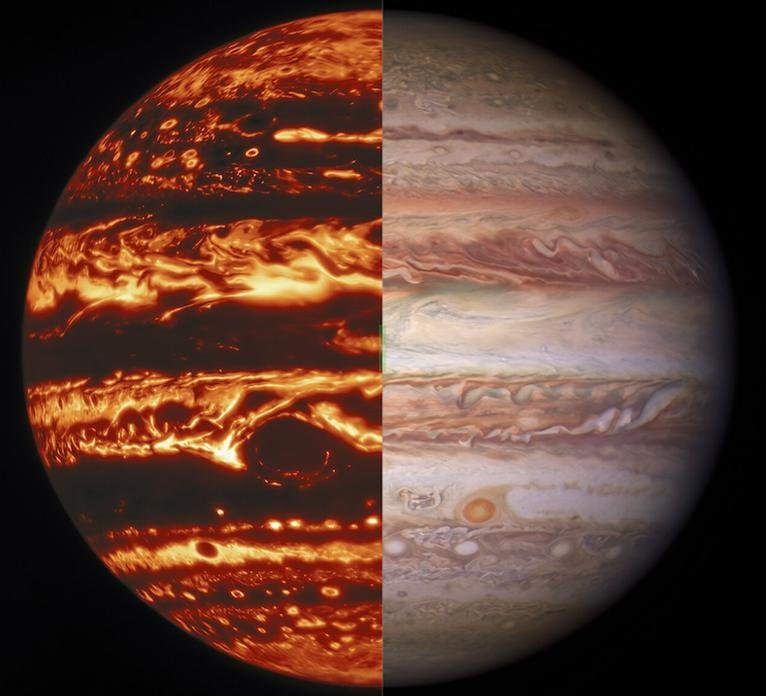Lhe NASA has discovered a geological wonder on Io, the fiery moon of Jupiter, the most volcanic world in the solar system. Flybys by the Juno probe have revealed unusually steep and previously unknown mountains, as well as surprising islands in a lava lake.
Header image: the moon Io as seen by Juno on December 30, 2023. (NASA/SWRI/ Kevin McGIll)
Using data from Juno, researchers created animations that showcase these volcanic lakes and towering mountains, a landscape that is both violent and strangely beautiful.
In this image, taken on July 5, 2022, 80,000 kilometers away, the shapes of lava flows and lava lakes can be seen as bright red spots. (NASA/JPL-Caltech/SwRI/ASI/INAF/JIRAM)
According to Scott Bolton, principal investigator of the Juno mission:
Io is simply dotted with volcanoes, and we caught a few in action. We also got stunning close-ups and other data on a 200-kilometer-long lava lake called Loki Patera. There are amazing details showing these bizarre islands embedded in the middle of a magma lake potentially lined with hot lava. The specular reflection of the lake recorded by our instruments suggests that parts of Io’s surface are as smooth as glass, reminiscent of the obsidian created by volcanoes on Earth.
This animation is an artistic representation of Loki Patera, a lava lake on Jupiter’s moon Io, created using data from the JunoCam imager aboard NASA’s Juno space probe. With several islands in its interior, Loki is a depression filled with magma and lined with molten lava. (NASA/JPL-Caltech/SwRI/MSSS)
Juno has been collecting data on Jupiter, its rings and moons (collectively known as the Jovian system) since mid-2016, when it arrived in this distant cosmic neighborhood after a 5-year journey. Since transmitting its first data, Juno has brought to science a succession of discoveries about the inner workings of the largest planet in the solar system and its satellites. For example, Juno revealed unprecedented images of Jupiter’s atmosphere, including enormous cyclones at both poles, as well as the planet’s deep internal structure. The probe also provided surprisingly detailed images of Jupiter’s clouds, highlighting their intricate patterns and vivid colors.
With each flyby, Juno moves closer and closer to the gas giant’s north pole. With each pass, the probe’s microwave radiometer (MWR) can study the north polar cycles with better resolution.
Jupiter’s banded appearance is created by the “weather layer” formed by clouds. In this composite image, the left image shows Jupiter’s thermal energy emitted in infrared light, with dark cloud bands appearing as silhouettes against Jupiter’s thermal glow. The image on the right shows Jupiter’s appearance in visible light, with the white cloud “zones” and relatively cloud-free “belts” appearing in red-brown colors. (International Gemini Observatory/NOIRLab/NSF/AURA/NASA/ESA)

According to Steve Levin, Juno project scientist at NASA’s Jet Propulsion Laboratory in Southern California:
Perhaps the most striking example of this disparity is the central cyclone at Jupiter’s north pole. It is clearly visible in infrared and visible light images, but its microwave signature is nowhere near as strong as that of other nearby storms. This tells us that its underground structure must be very different from that of other cyclones. The MWR team continues to collect more and better microwave data with each orbit. We therefore plan to develop a more detailed 3D map of these intriguing polar storms.
Another important aspect of Juno’s mission is the study of water abundance on Jupiter. Defines the distribution of water, or more precisely the distribution of hydrogen and oxygen, is crucial to reconstructing the origins of our solar system. Jupiter was probably the first planet to form in the solar system from all the gas and dust that was not incorporated by the Sun. Recent measurements indicate that the water content near Jupiter’s equator is several times higher than initial estimates, calling into question previous models based on data from the 1995 Galileo probe.
These results reinforce the idea that materials made of water ice may have contributed to the enrichment of Jupiter in heavy elements (chemical elements heavier than hydrogen and helium) during its formation or evolution. . However, Juno’s sightings are both enlightening and confusing. His data also indicates a surprisingly low water content in Jupiter’s core, which explains why the formation of the gas giant still eludes scientists.
Juno scientists were also able to recreate (video below) a spectacular feature on Io, an spire-shaped mountain that has been nicknamed ” The Steeple ” (the bell tower). This mountain is between 5 and 7 kilometers high. It is difficult to understand the type of volcanic activity that could have created such an astonishing landform.
(NASA/JPL-Caltech/SwRI/MSSS)
As Juno’s mission continues, new data could clarify differences in water abundance between Jupiter’s polar and equatorial regions and provide deeper insights into the planet’s enigmatic, diffuse core. Juno’s next major flyby is scheduled for May 12, and the scientific community is eagerly awaiting it. Each pass not only allows us to better understand the dynamics and composition of Jupiter’s atmosphere, but also to answer fundamental questions about the formation of our solar system.
The Juno team presented its latest findings at the European Geosciences Union General Assembly in Vienna and the study published in the journal Icarus: Super-adiabatic temperature gradient at Jupiter’s equatorial zone and implications for the water abundance and presented on the site from NASA: NASA’s Juno Gives Aerial Views of Mountain, Lava Lake on Io.








